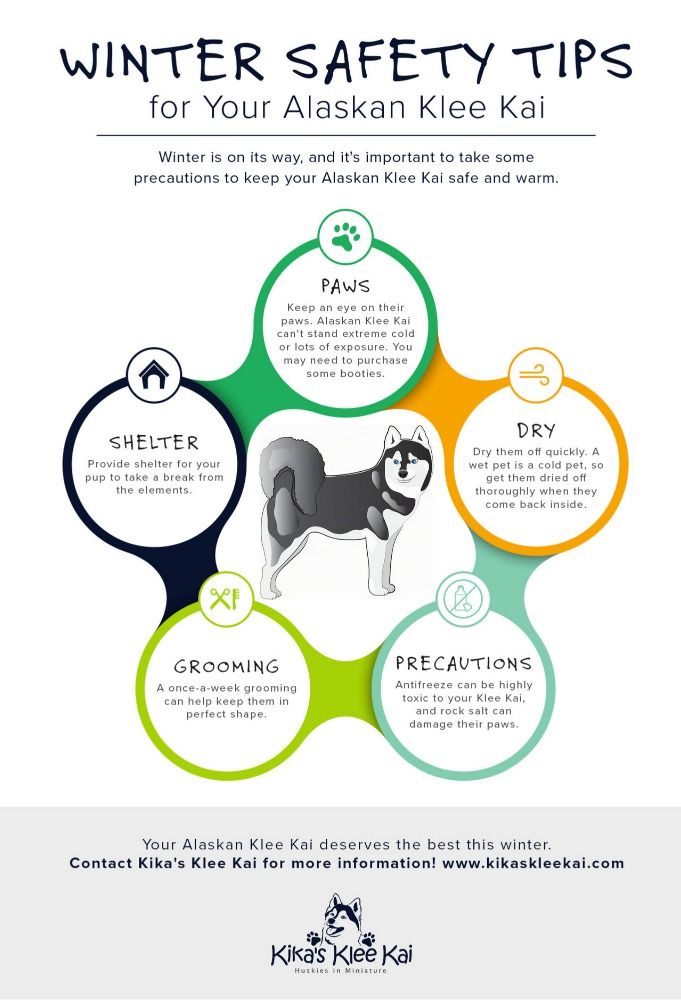It’s easy to look at their thick, fluffy coats and think that Alaskan Klee Kai don’t need any sort of special protection in the winter. After all, their name starts with “Alaskan”; how much more rugged and outdoorsy can you get? Well, as it turns out, our little Alaskan Klee Kai pals need our help to protect them from the elements, scary chemicals and more during the winter months. Let’s dive into some tips on how to protect your Alaskan Klee Kai this winter:
Bring your dog inside as quickly as possible.
Don’t leave your pup outside for extended periods of time in inclement weather, especially if it is snowing or icy out. The thermometer may say one thing, but if your pet is begging to come in, absolutely let them in! Ideally, get them inside before they’re so cold they are begging to come in. Frostbite and frostnip sets in quickly, especially with smaller dogs like the Klee Kai.
Give them a good shelter outside.
If your dog is going to be outside for any period of time during a snowfall or otherwise inhospitable weather, they need a sound shelter that won’t leak freezing ice on them and will keep them protected from exposure. A doghouse is fine, or if you have an outdoor shed where they have a place to curl up, something like that is okay too. It’s important that they have a place where they can find relief from the elements, especially since they may not know where you are.
Introduce them to extreme temperatures gradually.
Alaskan Klee Kai have thinner paw pads than their namesake breed, the Alaskan husky. The cold can very quickly overwhelm them; it may be necessary to purchase paw booties for your pup so that they can get around comfortably in the winter. Take cues from your dog and watch them closely; if they are limping or walking awkwardly, it’s time to get them inside.
Dry wet dogs off thoroughly.
Those beautiful coats sure do take on a lot of water, don’t they? If your Alaskan Klee Kai is wet, they are cold, too. Make sure to dry them off thoroughly if they are wet when they come in from outside.
Give them plentiful food and water.
Your Klee Kai is burning more calories playing in the snow during the winter than lounging around during the summer, so you may need to adjust how much they are eating. Make sure outdoor water bowls are easily locatable and filled regularly with fresh water. Snow doesn’t count! Your Alaskan Klee Kai needs to be able to stay hydrated.
Groom your Alaskan Klee Kai regularly.
If you have owned your pup for awhile you are familiar with how much they shed; if you haven’t, don’t worry: it’s not as much as you think, as long as it is maintained (and except for when they are blowing their coats). A weekly grooming routine to get rid of loose fur and keep your pup’s coat healthy and vibrant is plenty.
Be especially aware of antifreeze and rock salt.
Your Klee Kai, like most dogs, probably likes the taste of antifreeze. It tastes sweet to them, so they like licking it up, especially where it pools in driveways and at intersections. Unfortunately, while there is non-toxic antifreeze out there, there is also the highly toxic variety. Since you can’t know which is which, keep your dog from licking puddles or spots on the road. The toxic stuff is extremely dangerous and if you think your dog may have ingested some, you need to take them to the vet immediately.
Rock salt can damage your dog’s paws, and if you live somewhere that gets snow, it is everywhere, all winter long. They begin salting the roads at the first sign of ice and they don’t stop until spring is feathering a robin’s nest, and the chemicals from the industrial strength salts that are used are particularly harmful to your Alaskan Klee Kai’s paws. Protect your buddy’s paws by wiping them clean thoroughly every time they come inside.

